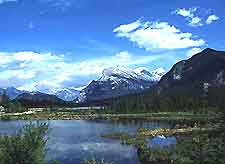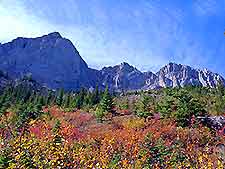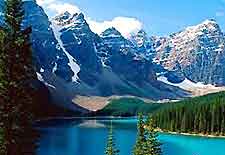Banff History Facts and Timeline
(Banff, Alberta, Canada)

Overlooking the Bow Valley at 1,463 meters / 4,800 feet above sea level, Banff is the second-highest community in Canada. Humans are believed to have inhabited the valley since around 11,000 BC. Native Indian tribes lived in relative harmony at this time in Banff history, leading busy lives and trading with each other. European settlers arrived in around 1700, changing the landscape forever.
This period of history saw the completion of the country's first transcontinental railway and the important discovery of a cluster of hot springs, situated on Sulphur Mountain.
The European Influx
In the 1700s, the once harmonious atmosphere which prevailed over the Canadian Rockies was disturbed by the first European settlers. They not only took lands through violence, but they also introduced deadly diseases such as smallpox. Religious services were conducted for natives on the shores of Lake Minnewanka, now a popular destination among cyclists, hikers and anglers.
From 1857 to 1860, a member of the British-led Palliser Expedition, James Hector, highlighted Banff for its potential with regards to future settlement and development. Present-day visitors to Banff will notice many mountains in the area named after this explorer.

1883 - a Golden Year
The year 1883 is considered to be one of the most important years in the history of Banff. The transcontinental railway was completed, passing through Banff on the way to
Lake Louise. More importantly, three railway workers accidently discovered a group of hot springs on what is today called Sulphur Mountain. This single event led to the creation of the Rocky Mountains Park in 1885 - the very first national park in Canada. Not only was this event crucial to the history of Banff, but it was also considered to be the birth of Canadian tourism. The original hot springs, now a National Historic Site which ranks amongst the town's main attractions, is known as Cave and Basin.
The Growth of Banff
From 1886 onwards, massive investment in the infrastructure around the hot springs included the construction of bridges, roads and the opening of the Banff Springs Hotel. The log-framed hotel was rebuilt in the early 20th century, but remains one of the town's most recognisable sights. Furthermore, the Upper Hot Springs on Sulphur Mountain remain one of the most popular attractions.
From 1900 onwards, Bill and Jim Brewster dominated guiding in the town, leading visitors into the surrounding mountains. These days, visitors can put themselves in the shoes of early tourists by taking the Banff Gondola up Sulphur Mountain, where you can stroll along the Banff Skywalk and enjoy some breathtaking panoramas.

Banff National Park
In 1930, the Rocky Mountains Park changed its name to the Banff National Park. Getting to Banff was made easier in 1962 when the Trans-Canadian Highway was opened, while cheap airfares further helped to increase the town's popularity among international visitors.
In 1984, Banff cemented its position as the leading national park in Canada, when it was recognised as a World Heritage Site. The town itself reached a highpoint in 1990, when it received independent municipality status - a big step from its origins as a small settlement catering to only a handful of visitors.
 Overlooking the Bow Valley at 1,463 meters / 4,800 feet above sea level, Banff is the second-highest community in Canada. Humans are believed to have inhabited the valley since around 11,000 BC. Native Indian tribes lived in relative harmony at this time in Banff history, leading busy lives and trading with each other. European settlers arrived in around 1700, changing the landscape forever.
Overlooking the Bow Valley at 1,463 meters / 4,800 feet above sea level, Banff is the second-highest community in Canada. Humans are believed to have inhabited the valley since around 11,000 BC. Native Indian tribes lived in relative harmony at this time in Banff history, leading busy lives and trading with each other. European settlers arrived in around 1700, changing the landscape forever.
